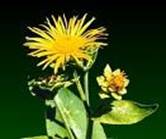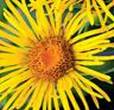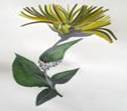| Kingdom | Plantae |
| Division | Magnoliophyta |
| Class | Magnoliopsida |
| Order | Asterales |
| Family | Asteraceae |
| Genus | Inula |
| Species | I. helenium |
| Binomial name | Inula helenium |
Other Common Names:
The other common names for the herb elecampane are Wild sunflower, Horseheal, Yellow Starwort, Scabwort, Elf Dock and Velvet Dock.
History
Elecampane was known to the ancient writers on agriculture and natural history, and even the Roman poets were acquainted with it, and mention Inula as affording a root used both as a medicine and a condiment.Inula, the Latin classical name for the plant, is considered to be a corruption of the Greek word Helenion which in its Latinized form, Helenium, is also now applied to the same species. There are many fables about the origin of this name.

Description
Elecampane is a perennial herb common to damp pastures and fields and roadsides in the eastern and central portions of the U.S. and Canada. The plant springs from a perennial rootstock, which is large and succulent, spindle shaped and branching, brown and aromatic, with large, fleshy roots. The plant grows anywhere from 3 to 6 feet in height, has a stout, branched stem.



After the flowers have fallen, these involucral scales spread horizontally, and the removal of the fruit shows the beautifully regular arrangement of the little pits on the receptacle, which form a pattern like the engine-turning of a watch.The fruit is quadrangular and crowned by a ring of pale-reddish hairs - the pappus.The plant is in bloom from June to August.
Range
It is found wild throughout continental Europe, from Gothland southwards, and extends eastwards in temperate Asia as far as Southern Siberia and North-West India. As a plant of cultivation, it has wandered to North America, where it has become thoroughly naturalized in the eastern United States, being found from Nova Scotia to Northern Carolina, and westward as far as Missouri, growing abundantly in pastures and along roadsides, preferring wet, rocky ground at or near the base of eastern and southern slopes.
Habitat
Elecampane grows best in damp pastures and shady ground. It grows well in moist, shady positions, in ordinary garden soil, though it flourishes best in a good, loamy soil, the ground being damp, but fairly well-drained.
Cultivation
The best way to propagate elecampane is from offshoots or root cuttings taken in autumn from a mature plant. The root pieces should be about 2 inches long. Cover them with slightly moist, sandy soil and store them over the winter in a room with a constant temperature between 50 and 60 F degrees. The roots will develop into new plants by spring, and you can set these out after the danger of frost is past. Place them in rows 3 feet apart, with about 18 inches between plants. Elecampane prefers a clay loam that is moist and well drained in a damp, somewhat shaded environment.
It is easily cultivated. Seeds may be sown, either when ripe, in cold frames, or in spring in the open. It is best propagated, however, by off-sets, taken in the autumn from the old root, with a bud or eye to each. These will take root very readily, and should be planted in rows about a foot asunder and 9 or 10 inches distant in the rows. In the following spring, the ground should be kept clean from weeds, and if slightly dug in autumn, it will greatly promote the growth of the roots, which will be fit for use after two years' growth.
Parts Used

The herb, roots and the root stock of the plant elecampane are of both medicinal and commercial use.
Flowering Season
The flowers of the Elecampane are in bloom between early summers to midsummer.
Pests and Diseases
It is resistant to most common plant pests and diseases. However, the elecampane is vulnerable to root rot especially when it is growing in soggy soils.
Medicinal and Commercial Applications

• Elecampane is candied and eaten as a sweetmeat.
• Elecampane is used in treating in certain diseases of women, also in phthisis, in dropsy and in skin affections.
• A decoction of the plant is said to cure sheep affected with the scab, and the cutaneous diseases of horses.
• It is chiefly used for coughs, consumption and other pulmonary complaints, being a favourite domestic remedy for bronchitis asthma.
• The root used not only to be candied and eaten as a sweetmeat, but lozenges were made of it.
• Externally applied, it is somewhat rubefacient, and has been employed as an embrocation in the treatment of sciatica, facial and other neuralgia.
• Elecampane has been taken traditionally as a tonic herb for the digestion. It stimulates the appetite and relieves dyspepsia. Elecampane is a useful remedy for the treatment of worms.
• Taken regularly as a general tonic or for long-standing chronic respiratory complaints.
• Elecampane acts as a digestive tonic and liver stimulant.

The Greeks named it Inula for Helen, wife of Meneluas, who was believed to have had an armful of the plant when Paris abducted her to Phrygia. Another legend states that it sprang from her tears: another that Helen first used it against venomous bites; a fourth, that it took the name from the island Helena, where the best plants grew.
The plant's specific name, helenium, derives from Helen of Troy; elecampane is said to have sprung up from where her tears fell. It was sacred to the ancient Celts, and once had the name "elfwort".A 9-herb blend of elecampane, Rue, Nettle, Verbena, Yarrow, Mugwort, Wood Betony, Celandine, and White Clover is an old European-style tea-bath for Protection against Witches. ELECAMPANE Tea is also used to wash the face and hands to keep the Skin Free from Blemishes. The common name horse-heal may refer to this wild sunflowers traditional use in healing skin infections in horses and sheep.